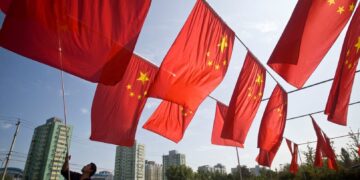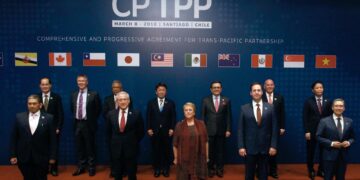Though China’s Latin America investment policy mainly targets raw materials, the country is broadening its approach to develop balanced bilateral relations.
by Michael Diaz, Jr. and Robert Q. Lee
In the last decade, China has successfully built strong commercial and investment relationships with Latin American and Caribbean countries. Before the global economic crisis hit last fall, China’s nearly insatiable demand for commodities to fuel its rapidly growing economy provided a powerful stimulus throughout the region. Now, despite the global economic downturn, China continues to pour billions of dollars into Latin America through investments, loans, acquisitions, and currency swaps. By striving to reduce the recession’s impact, China hopes to be perceived as a friendly economic partner rather than a competitor and to lay the foundation for stable, long-term commercial relations. The result is likely to be a new balance between China and Latin America that will have significant consequences for the United States, Europe, Asia, and the entire global economy.
A strategic approach
China’s 11th Five-Year Plan (FYP, 2006-10) offers a good starting point to understand the country’s official overseas investment priorities. The FYP’s main objectives are to maintain economic growth while conserving energy and national resources.
China’s Latin America policy became clearer when the PRC government launched its first policy paper on the region in November 2008. According to China’s Policy Paper on Latin America and the Caribbean, Beijing “seeks to build and develop a comprehensive and cooperative partnership featuring equality, mutual benefit, and common development” in the region. In terms of the economic relationship, the paper describes plans to cooperate on trade, investment, finance, agriculture, industry, natural resources and energy, infrastructure construction, tourism, customs, and quality inspection. The paper also lists plans to cooperate on science, technology, and education; medicine and healthcare; and environmental protection, as well as to cooperate in the political arena.
Trade soars
China-Latin America trade hit $143.4 billion in 2008, up nearly 260 percent over 2004 (see Table). China is now Latin America’s second-largest (and Brazil’s largest) trade partner, after the United States. Much of China’s trade focuses on the energy and mining sectors, where Latin America is a major supplier and has substantial reserves.
Currently, China relies on imports for half of its oil consumption, totaling 7.6 million barrels a day. Estimates from the International Energy Agency suggest that this figure could rise to 75 percent of consumption by 2030. China looks to Latin America—especially Venezuela and Brazil—to supplement its supplies from the Middle East, Africa, and Asia. Though Latin America holds 13.3 percent of the world’s estimated oil reserves, the region accounts for only 6 percent of total output because of inadequate infrastructure. For example, Venezuela extracts only about 973.5 million barrels of oil a year, even though its reserves are the region’s largest at 87 billion barrels.
Venezuela’s oil reserves have certainly attracted Beijing’s attention. In the past four years, China has signed more than 20 agreements with President Hugo Chávez and promised Venezuela substantial long-term investments in exchange for oil. In his last trip to China, Chávez projected that Venezuelan oil exports to China will rise from the current 331,000 barrels per day to 1 million barrels per day by 2012. This will further fuel China’s growth and diversify Venezuela’s export markets. To make Chávez’s vision a reality, the Venezuelan and PRC governments created a multi-million dollar joint investment fund to finance development projects—primarily for oil production and infrastructure.
Brazil also figures prominently into China’s Latin American oil strategy. With an annual production of 831.1 million barrels, Brazil has the second-largest oil reserve in the region—12.2 billion barrels. China is aware of Brazil’s potential and, through the China Development Bank, earlier this year agreed to lend the Brazilian oil giant Petróleo Brasileiro SA (Petrobras) $10 billion in exchange for a long-term supply of 160,000 barrels a day at market prices.
Chinese interest in Latin America covers other commodities as well. Latin America boasts 40 percent of the world’s known copper reserves, as well as an important share of iron, silver, and tin. In turn, China accounts for more than 22 percent of world copper demand and is a major consumer of tin and iron ore. China obtains much of its copper from Chile.
Agricultural products are another source of interest. Because China has 20 percent of the world’s population but only 7 percent of its arable land, it must import many agricultural products, especially land-intensive crops such as soybeans. China imported 37.4 million metric tons (mmt) of soybeans in 2008 (worth $21.8 billion), nearly all of which came from the United States, Brazil, and Argentina. In the first 10 months of 2008, China bought 11.1 mmt of soybeans from Brazil, 10.6 mmt from the United States, and 8.6 mmt from Argentina. With a growing population and limited arable land, China will likely view Latin America as an increasingly important source of agricultural products.
Investment opportunities open up
In addition to trade in goods, the PRC government and private companies have also made substantial investments in Latin America aimed at securing the region’s natural resources. At the 2004 Asia-Pacific Economic Cooperation summit in Chile, the PRC government promised to invest $100 billion in Latin America over the next decade. After a slow beginning, Chinese money is now flowing into the region, including a $3 billion deal by the Aluminum Corp. of China (Chinalco) for the Toromocho mines in Peru. China Minmetals Nonferrous Metals Co. also invested $2 billion in a joint venture (JV) with Chile’s state copper giant Corporación Nacional del Cobre de Chile, and Baoshan Iron and Steel invested $1.4 billion in a JV with Brazilian iron-ore giant Companhia Vale Do Rio Doce to construct a new steel plant in Brazil.
Chinese investment also targets infrastructure projects. For instance, the Chinese consortium Sinohydro-Andes plans to invest more than $2 billion in the construction of Ecuador’s biggest hydroelectric plant, the Coca Codo Sinclair. Similar investment opportunities exist throughout the region. According to a World Bank report, overall, Latin American countries spend less than 2 percent of gross domestic product (GDP) on infrastructure, raising logistics costs by an estimated 15-34 percent of a product’s value. In contrast, industrialized countries spend roughly 10 percent of GDP on infrastructure.
To counteract the global recession, many Latin American governments are initiating labor-intensive urban transportation, water, and waste system projects, many of which began in the second quarter of 2009. For example, Brazil plans to spend roughly $254 billion on infrastructure projects through 2010, and Mexico plans to spend $3.4 billion on infrastructure to boost growth and employment. All of these economic stimulus programs have created enormous opportunities for China to strengthen its relationships by supplying vital investment dollars, and Chinese companies are bidding on contracts.
Diplomatic initiatives
In seeking to build stronger commercial ties, China is also taking steps to improve its diplomatic relations in Latin America, especially in Central America, and in the Caribbean. Many of those countries maintain diplomatic relations with Taipei, largely because of the massive international aid that Taiwan provided in the past.
To gain more support in the region, China has increased its international aid programs significantly. Costa Rica provides a good example of a PRC diplomatic success. Since Costa Rica switched its recognition from Taipei to Beijing in June 2007, Costa Rican President Oscar Arias has signed 11 agreements with China on economics, culture, trade, technology, tourism, immigration, and finance. One of the most important agreements was a $1.2 billion investment that will be carried out through a JV between the Refinería Costarricense de Petróleo and state-owned China National Petroleum Corp. The trade relationship between China and Costa Rica is also expanding—China’s imports from Costa Rica exceeded $680 million in 2008. China plans to sign a free-trade agreement (FTA) with Costa Rica before Arias leaves office in 2010. If that occurs, Costa Rica would become the third Latin American country to sign an FTA with China, following Chile in 2006 and Peru in 2009. Beijing hopes its newly established relations with Costa Rica will set an example for its Central American neighbors and lead to similar trade agreements throughout the region.
Gaining momentum
Many Latin American governments are paying closer attention to the PRC economic model because China has been less severely affected by the global slowdown than the United States and other leading capitalist countries. China’s influence in Latin America has also grown because the US government did not prioritize its relationship with Latin America during the Bush administration. After September 11, 2001, Afghanistan, Iraq, and the Middle East occupied the attention of US policymakers, leaving a hole for China to fill. In addition, China’s policy of making investments without regard to the host country’s domestic affairs has given China a huge advantage in Latin America and Africa.
It is also important to understand China’s motive behind its foreign policy moves and investment decisions—long-term stability rather than short-term profits. In contrast to publicly traded US companies, whose shareholders typically demand immediate returns, Chinese companies—and the government itself—are looking beyond short-term profitability to achieve long-term goals, such as energy and food security. In fact, the PRC government is involved in many aspects of the nation’s foreign investment decisions, especially those involving large state-owned enterprises.
Treading with care to achieve success
Under its current FYP, China’s foreign policy toward Latin America focuses on the acquisition of natural resources that can support the country’s economy for years to come. To achieve that goal and continue its recent achievements, China must maintain a positive image and carefully consider its export policies, especially in the mature manufacturing sector. That means China must avoid, as much as possible, negatively affecting Latin American countries that seek to expand their own manufacturing and export production. For instance, Central American countries are relatively vulnerable in the manufacturing sector, where China has its biggest strength—one reason so many of these countries have historically maintained political ties with Taipei.
Today, most Latin American countries are willing to cooperate with China, as Beijing adopts an active and supportive role in the region. Successes such as the China-Venezuela relationship demonstrate the benefits both nations derive from fostering a relationship based on mutual respect and cooperation. It is an important development for China, Latin America and the Caribbean, and the world.
[box]
Strengthening the Renminbi in Latin America
Concerned that China’s massive US debt holdings could decrease in value because of US deficit spending, People’s Bank of China Governor Zhou Xiaochuan suggested in March that a new super-sovereign reserve currency replace the US dollar as a global trade medium of exchange. Zhou has since said that China will not make any sudden changes to its reserve policies.
The renminbi (RMB) has had little impact on international trade to date, but the situation could change in the next few decades. China has begun experimenting with using RMB to settle cross-border trade deals with certain countries, including a few in Latin America. In late March, Argentina became the first Latin American country to sign a currency-swap agreement with China. The three-year, ¥70 billion ($10 billion) agreement extends China’s efforts to reach economic accords that do not involve the dollar and provides dollar-scarce countries such as Argentina with an alternative currency to pay for its imports from China. This trend is likely to continue, and if trade between China and its top-five trading partners in Latin America surpasses $200 billion, the use of the RMB in Latin America could soar.
—Michael Diaz, Jr. and Robert Q. Lee
[/box]
[author] Michael Diaz, Jr. is managing partner, and Robert Q. Lee is a partner, at Diaz Reus & Targ, LLP in Miami, Florida. [/author]































